University Counselling Skills: Person-Centred Approach Critique
VerifiedAdded on 2022/08/29
|7
|1928
|94
Report
AI Summary
This report offers a detailed analysis of a counselling session, focusing on the application of micro-skills within a person-centered approach. The student critically evaluates the communication skills demonstrated by the therapist, highlighting strengths such as building rapport and exhibiting a non-judgmental attitude. The analysis delves into the application of specific micro-skills like attending behavior, questioning, confrontation, focus, and reflection of meaning, offering suggestions for improvement, such as utilizing more direct questioning techniques. The report also critiques the therapist's ability to conclude the session and foster a genuine connection with the client, pointing out areas where interjections and a lack of direct eye contact could have been improved. Ultimately, the report concludes by emphasizing the effectiveness of the person-centered approach in addressing mental health issues, while providing constructive criticism and relevant references to support the analysis. The student links observations of the use of skills, and their outcomes, to the principles of person centred counselling.

Running head: COUNSELLING SKILLS
COUNSELLING SKILLS
Name of the student
Name of the university
Author Note
COUNSELLING SKILLS
Name of the student
Name of the university
Author Note
Paraphrase This Document
Need a fresh take? Get an instant paraphrase of this document with our AI Paraphraser
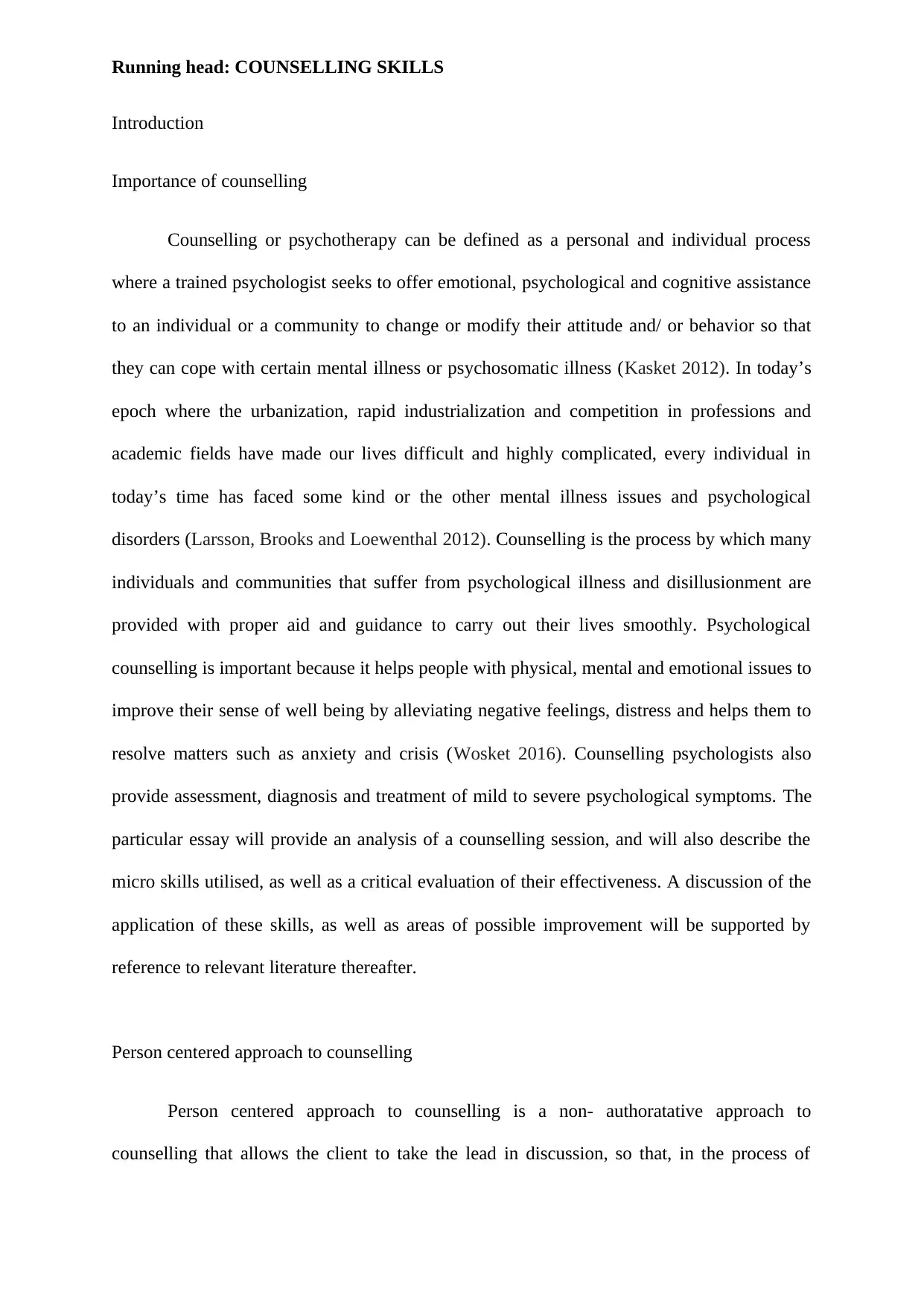
Running head: COUNSELLING SKILLS
Introduction
Importance of counselling
Counselling or psychotherapy can be defined as a personal and individual process
where a trained psychologist seeks to offer emotional, psychological and cognitive assistance
to an individual or a community to change or modify their attitude and/ or behavior so that
they can cope with certain mental illness or psychosomatic illness (Kasket 2012). In today’s
epoch where the urbanization, rapid industrialization and competition in professions and
academic fields have made our lives difficult and highly complicated, every individual in
today’s time has faced some kind or the other mental illness issues and psychological
disorders (Larsson, Brooks and Loewenthal 2012). Counselling is the process by which many
individuals and communities that suffer from psychological illness and disillusionment are
provided with proper aid and guidance to carry out their lives smoothly. Psychological
counselling is important because it helps people with physical, mental and emotional issues to
improve their sense of well being by alleviating negative feelings, distress and helps them to
resolve matters such as anxiety and crisis (Wosket 2016). Counselling psychologists also
provide assessment, diagnosis and treatment of mild to severe psychological symptoms. The
particular essay will provide an analysis of a counselling session, and will also describe the
micro skills utilised, as well as a critical evaluation of their effectiveness. A discussion of the
application of these skills, as well as areas of possible improvement will be supported by
reference to relevant literature thereafter.
Person centered approach to counselling
Person centered approach to counselling is a non- authoratative approach to
counselling that allows the client to take the lead in discussion, so that, in the process of
Introduction
Importance of counselling
Counselling or psychotherapy can be defined as a personal and individual process
where a trained psychologist seeks to offer emotional, psychological and cognitive assistance
to an individual or a community to change or modify their attitude and/ or behavior so that
they can cope with certain mental illness or psychosomatic illness (Kasket 2012). In today’s
epoch where the urbanization, rapid industrialization and competition in professions and
academic fields have made our lives difficult and highly complicated, every individual in
today’s time has faced some kind or the other mental illness issues and psychological
disorders (Larsson, Brooks and Loewenthal 2012). Counselling is the process by which many
individuals and communities that suffer from psychological illness and disillusionment are
provided with proper aid and guidance to carry out their lives smoothly. Psychological
counselling is important because it helps people with physical, mental and emotional issues to
improve their sense of well being by alleviating negative feelings, distress and helps them to
resolve matters such as anxiety and crisis (Wosket 2016). Counselling psychologists also
provide assessment, diagnosis and treatment of mild to severe psychological symptoms. The
particular essay will provide an analysis of a counselling session, and will also describe the
micro skills utilised, as well as a critical evaluation of their effectiveness. A discussion of the
application of these skills, as well as areas of possible improvement will be supported by
reference to relevant literature thereafter.
Person centered approach to counselling
Person centered approach to counselling is a non- authoratative approach to
counselling that allows the client to take the lead in discussion, so that, in the process of
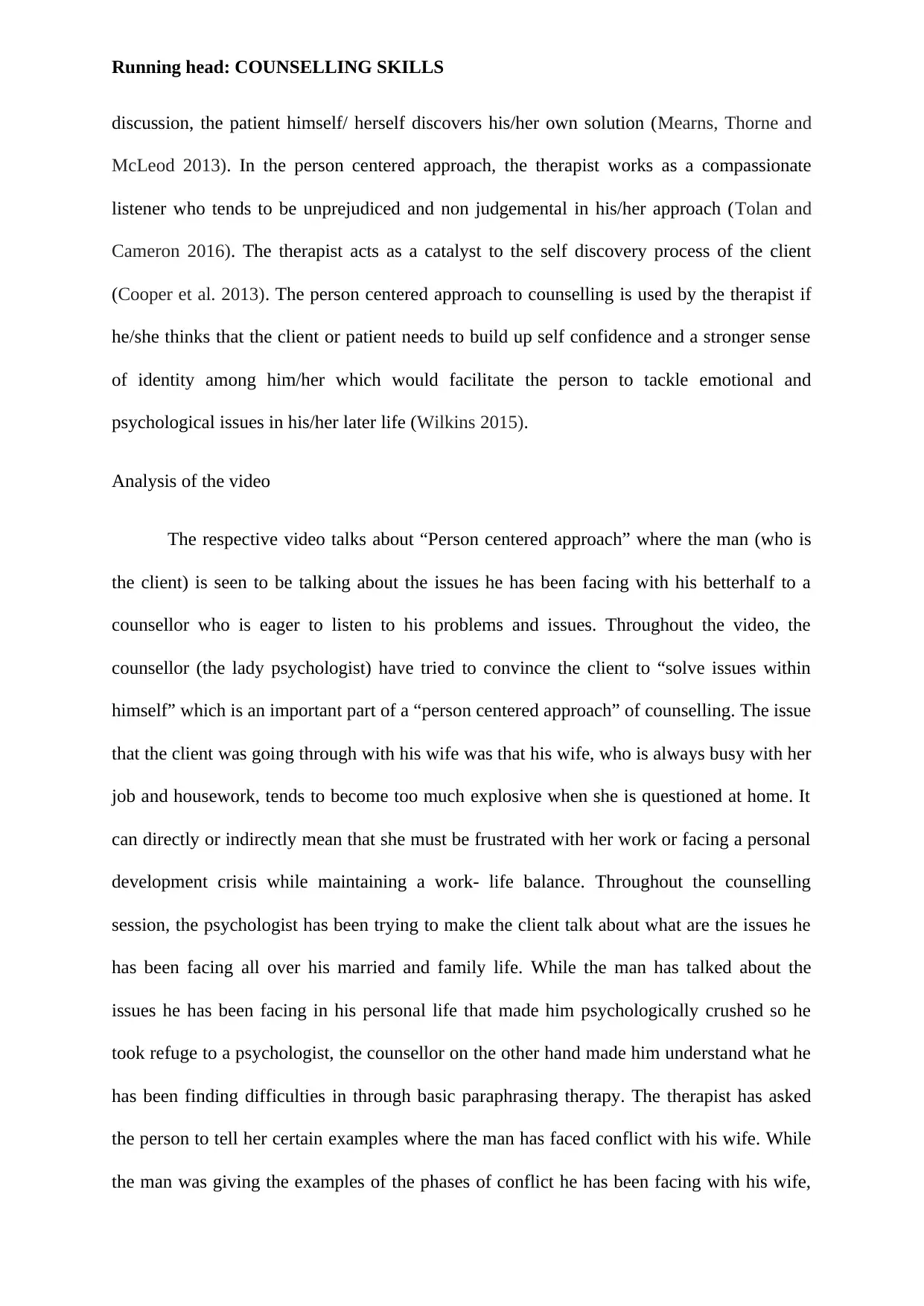
Running head: COUNSELLING SKILLS
discussion, the patient himself/ herself discovers his/her own solution (Mearns, Thorne and
McLeod 2013). In the person centered approach, the therapist works as a compassionate
listener who tends to be unprejudiced and non judgemental in his/her approach (Tolan and
Cameron 2016). The therapist acts as a catalyst to the self discovery process of the client
(Cooper et al. 2013). The person centered approach to counselling is used by the therapist if
he/she thinks that the client or patient needs to build up self confidence and a stronger sense
of identity among him/her which would facilitate the person to tackle emotional and
psychological issues in his/her later life (Wilkins 2015).
Analysis of the video
The respective video talks about “Person centered approach” where the man (who is
the client) is seen to be talking about the issues he has been facing with his betterhalf to a
counsellor who is eager to listen to his problems and issues. Throughout the video, the
counsellor (the lady psychologist) have tried to convince the client to “solve issues within
himself” which is an important part of a “person centered approach” of counselling. The issue
that the client was going through with his wife was that his wife, who is always busy with her
job and housework, tends to become too much explosive when she is questioned at home. It
can directly or indirectly mean that she must be frustrated with her work or facing a personal
development crisis while maintaining a work- life balance. Throughout the counselling
session, the psychologist has been trying to make the client talk about what are the issues he
has been facing all over his married and family life. While the man has talked about the
issues he has been facing in his personal life that made him psychologically crushed so he
took refuge to a psychologist, the counsellor on the other hand made him understand what he
has been finding difficulties in through basic paraphrasing therapy. The therapist has asked
the person to tell her certain examples where the man has faced conflict with his wife. While
the man was giving the examples of the phases of conflict he has been facing with his wife,
discussion, the patient himself/ herself discovers his/her own solution (Mearns, Thorne and
McLeod 2013). In the person centered approach, the therapist works as a compassionate
listener who tends to be unprejudiced and non judgemental in his/her approach (Tolan and
Cameron 2016). The therapist acts as a catalyst to the self discovery process of the client
(Cooper et al. 2013). The person centered approach to counselling is used by the therapist if
he/she thinks that the client or patient needs to build up self confidence and a stronger sense
of identity among him/her which would facilitate the person to tackle emotional and
psychological issues in his/her later life (Wilkins 2015).
Analysis of the video
The respective video talks about “Person centered approach” where the man (who is
the client) is seen to be talking about the issues he has been facing with his betterhalf to a
counsellor who is eager to listen to his problems and issues. Throughout the video, the
counsellor (the lady psychologist) have tried to convince the client to “solve issues within
himself” which is an important part of a “person centered approach” of counselling. The issue
that the client was going through with his wife was that his wife, who is always busy with her
job and housework, tends to become too much explosive when she is questioned at home. It
can directly or indirectly mean that she must be frustrated with her work or facing a personal
development crisis while maintaining a work- life balance. Throughout the counselling
session, the psychologist has been trying to make the client talk about what are the issues he
has been facing all over his married and family life. While the man has talked about the
issues he has been facing in his personal life that made him psychologically crushed so he
took refuge to a psychologist, the counsellor on the other hand made him understand what he
has been finding difficulties in through basic paraphrasing therapy. The therapist has asked
the person to tell her certain examples where the man has faced conflict with his wife. While
the man was giving the examples of the phases of conflict he has been facing with his wife,
⊘ This is a preview!⊘
Do you want full access?
Subscribe today to unlock all pages.

Trusted by 1+ million students worldwide
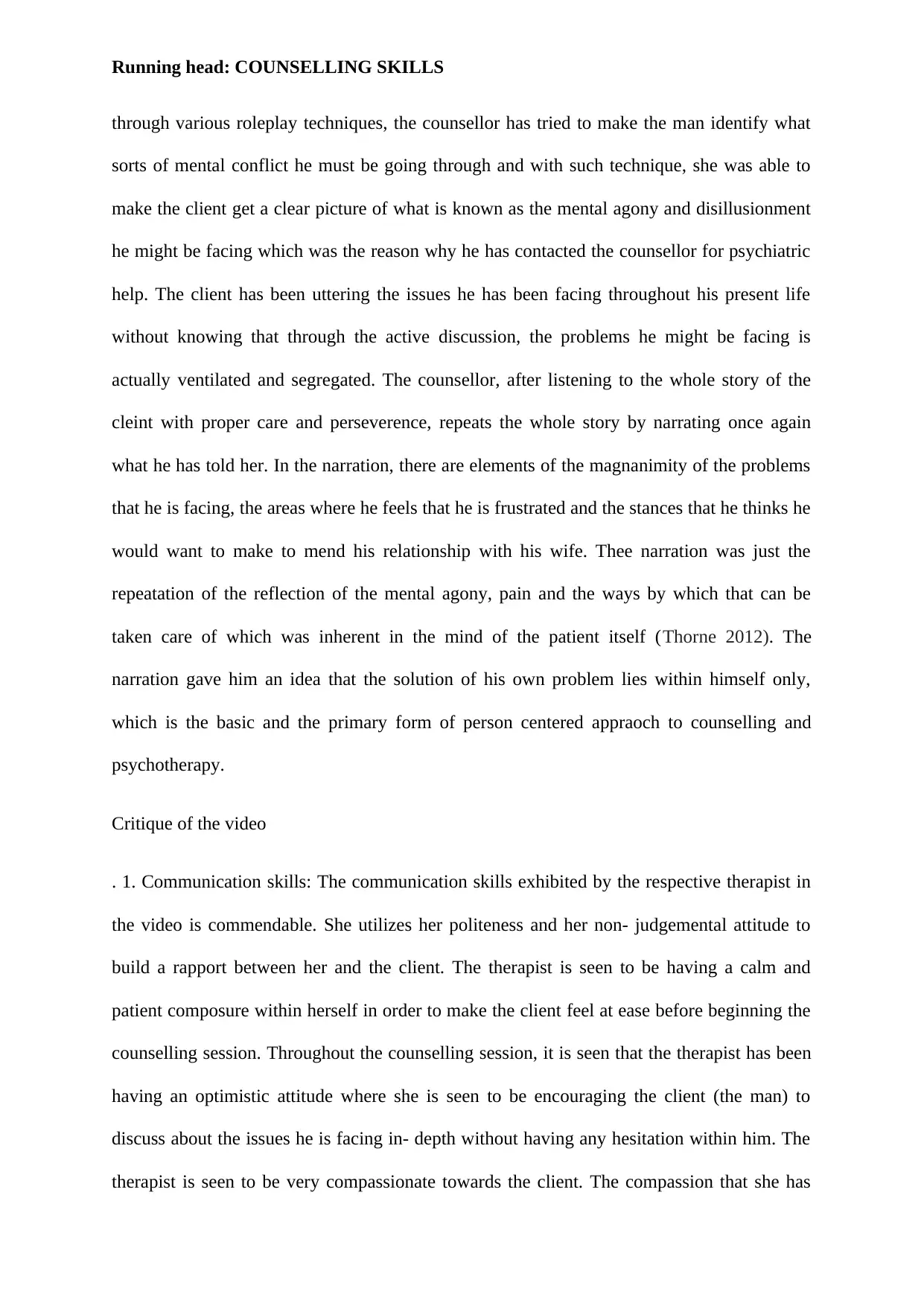
Running head: COUNSELLING SKILLS
through various roleplay techniques, the counsellor has tried to make the man identify what
sorts of mental conflict he must be going through and with such technique, she was able to
make the client get a clear picture of what is known as the mental agony and disillusionment
he might be facing which was the reason why he has contacted the counsellor for psychiatric
help. The client has been uttering the issues he has been facing throughout his present life
without knowing that through the active discussion, the problems he might be facing is
actually ventilated and segregated. The counsellor, after listening to the whole story of the
cleint with proper care and perseverence, repeats the whole story by narrating once again
what he has told her. In the narration, there are elements of the magnanimity of the problems
that he is facing, the areas where he feels that he is frustrated and the stances that he thinks he
would want to make to mend his relationship with his wife. Thee narration was just the
repeatation of the reflection of the mental agony, pain and the ways by which that can be
taken care of which was inherent in the mind of the patient itself (Thorne 2012). The
narration gave him an idea that the solution of his own problem lies within himself only,
which is the basic and the primary form of person centered appraoch to counselling and
psychotherapy.
Critique of the video
. 1. Communication skills: The communication skills exhibited by the respective therapist in
the video is commendable. She utilizes her politeness and her non- judgemental attitude to
build a rapport between her and the client. The therapist is seen to be having a calm and
patient composure within herself in order to make the client feel at ease before beginning the
counselling session. Throughout the counselling session, it is seen that the therapist has been
having an optimistic attitude where she is seen to be encouraging the client (the man) to
discuss about the issues he is facing in- depth without having any hesitation within him. The
therapist is seen to be very compassionate towards the client. The compassion that she has
through various roleplay techniques, the counsellor has tried to make the man identify what
sorts of mental conflict he must be going through and with such technique, she was able to
make the client get a clear picture of what is known as the mental agony and disillusionment
he might be facing which was the reason why he has contacted the counsellor for psychiatric
help. The client has been uttering the issues he has been facing throughout his present life
without knowing that through the active discussion, the problems he might be facing is
actually ventilated and segregated. The counsellor, after listening to the whole story of the
cleint with proper care and perseverence, repeats the whole story by narrating once again
what he has told her. In the narration, there are elements of the magnanimity of the problems
that he is facing, the areas where he feels that he is frustrated and the stances that he thinks he
would want to make to mend his relationship with his wife. Thee narration was just the
repeatation of the reflection of the mental agony, pain and the ways by which that can be
taken care of which was inherent in the mind of the patient itself (Thorne 2012). The
narration gave him an idea that the solution of his own problem lies within himself only,
which is the basic and the primary form of person centered appraoch to counselling and
psychotherapy.
Critique of the video
. 1. Communication skills: The communication skills exhibited by the respective therapist in
the video is commendable. She utilizes her politeness and her non- judgemental attitude to
build a rapport between her and the client. The therapist is seen to be having a calm and
patient composure within herself in order to make the client feel at ease before beginning the
counselling session. Throughout the counselling session, it is seen that the therapist has been
having an optimistic attitude where she is seen to be encouraging the client (the man) to
discuss about the issues he is facing in- depth without having any hesitation within him. The
therapist is seen to be very compassionate towards the client. The compassion that she has
Paraphrase This Document
Need a fresh take? Get an instant paraphrase of this document with our AI Paraphraser
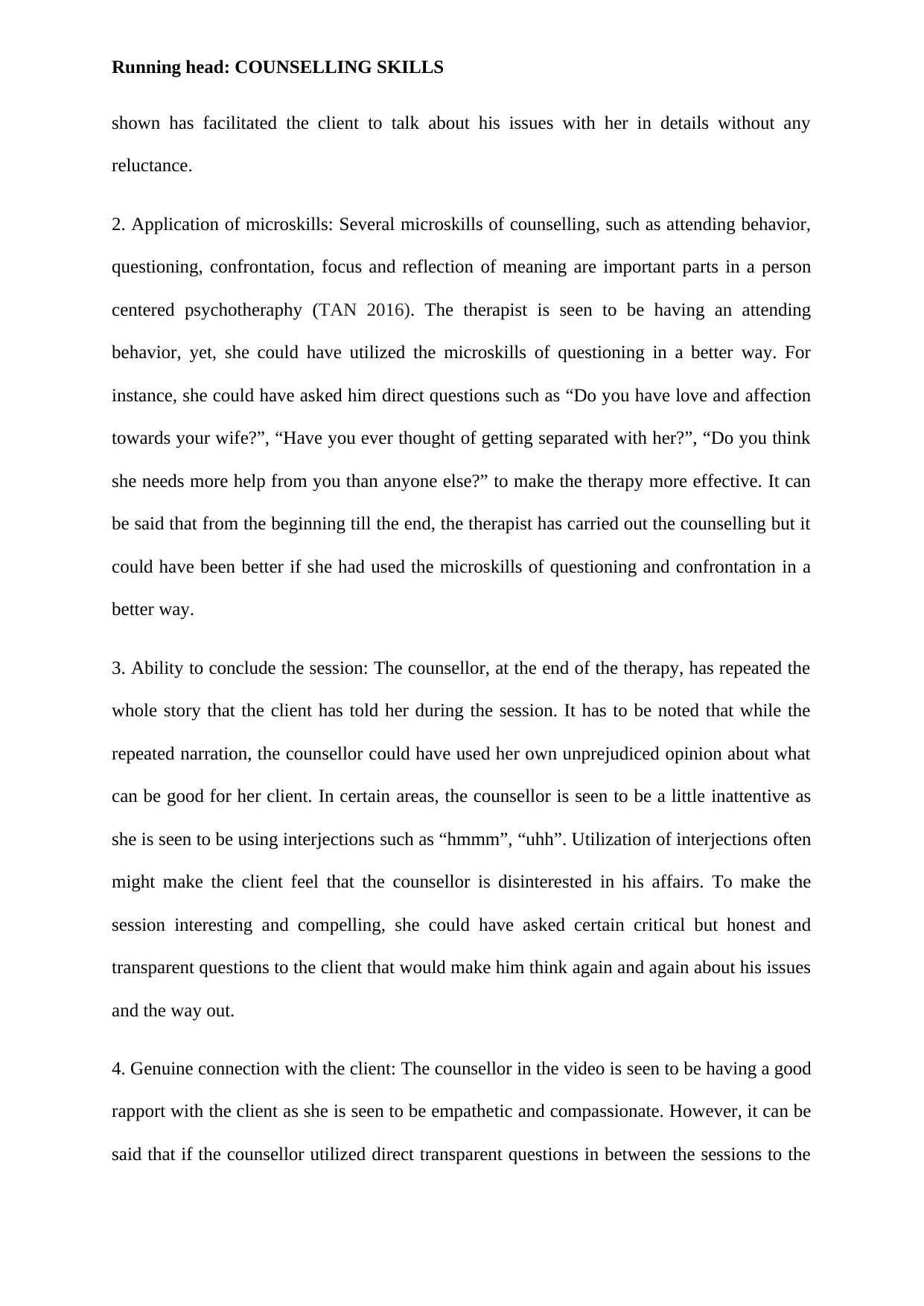
Running head: COUNSELLING SKILLS
shown has facilitated the client to talk about his issues with her in details without any
reluctance.
2. Application of microskills: Several microskills of counselling, such as attending behavior,
questioning, confrontation, focus and reflection of meaning are important parts in a person
centered psychotheraphy (TAN 2016). The therapist is seen to be having an attending
behavior, yet, she could have utilized the microskills of questioning in a better way. For
instance, she could have asked him direct questions such as “Do you have love and affection
towards your wife?”, “Have you ever thought of getting separated with her?”, “Do you think
she needs more help from you than anyone else?” to make the therapy more effective. It can
be said that from the beginning till the end, the therapist has carried out the counselling but it
could have been better if she had used the microskills of questioning and confrontation in a
better way.
3. Ability to conclude the session: The counsellor, at the end of the therapy, has repeated the
whole story that the client has told her during the session. It has to be noted that while the
repeated narration, the counsellor could have used her own unprejudiced opinion about what
can be good for her client. In certain areas, the counsellor is seen to be a little inattentive as
she is seen to be using interjections such as “hmmm”, “uhh”. Utilization of interjections often
might make the client feel that the counsellor is disinterested in his affairs. To make the
session interesting and compelling, she could have asked certain critical but honest and
transparent questions to the client that would make him think again and again about his issues
and the way out.
4. Genuine connection with the client: The counsellor in the video is seen to be having a good
rapport with the client as she is seen to be empathetic and compassionate. However, it can be
said that if the counsellor utilized direct transparent questions in between the sessions to the
shown has facilitated the client to talk about his issues with her in details without any
reluctance.
2. Application of microskills: Several microskills of counselling, such as attending behavior,
questioning, confrontation, focus and reflection of meaning are important parts in a person
centered psychotheraphy (TAN 2016). The therapist is seen to be having an attending
behavior, yet, she could have utilized the microskills of questioning in a better way. For
instance, she could have asked him direct questions such as “Do you have love and affection
towards your wife?”, “Have you ever thought of getting separated with her?”, “Do you think
she needs more help from you than anyone else?” to make the therapy more effective. It can
be said that from the beginning till the end, the therapist has carried out the counselling but it
could have been better if she had used the microskills of questioning and confrontation in a
better way.
3. Ability to conclude the session: The counsellor, at the end of the therapy, has repeated the
whole story that the client has told her during the session. It has to be noted that while the
repeated narration, the counsellor could have used her own unprejudiced opinion about what
can be good for her client. In certain areas, the counsellor is seen to be a little inattentive as
she is seen to be using interjections such as “hmmm”, “uhh”. Utilization of interjections often
might make the client feel that the counsellor is disinterested in his affairs. To make the
session interesting and compelling, she could have asked certain critical but honest and
transparent questions to the client that would make him think again and again about his issues
and the way out.
4. Genuine connection with the client: The counsellor in the video is seen to be having a good
rapport with the client as she is seen to be empathetic and compassionate. However, it can be
said that if the counsellor utilized direct transparent questions in between the sessions to the
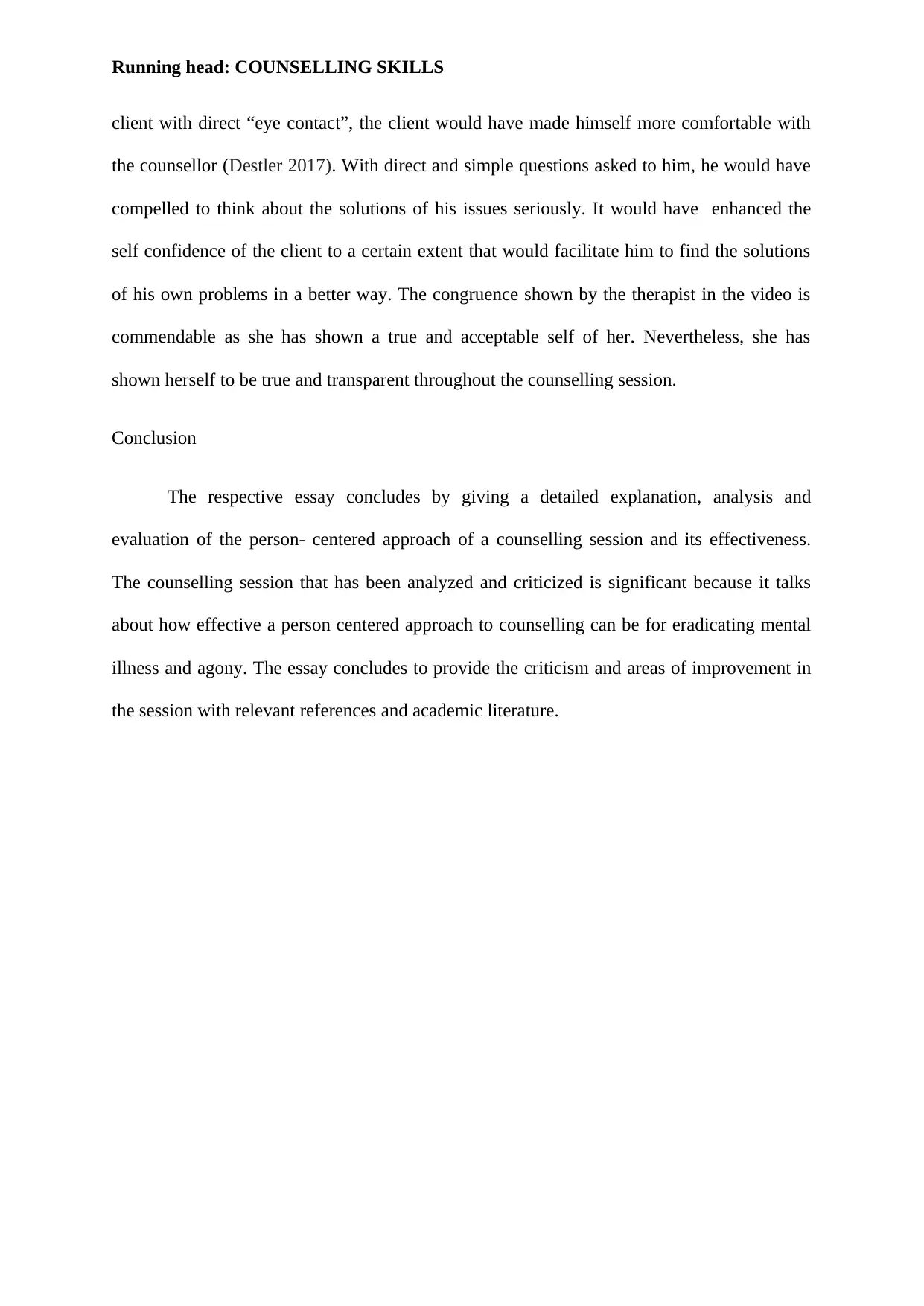
Running head: COUNSELLING SKILLS
client with direct “eye contact”, the client would have made himself more comfortable with
the counsellor (Destler 2017). With direct and simple questions asked to him, he would have
compelled to think about the solutions of his issues seriously. It would have enhanced the
self confidence of the client to a certain extent that would facilitate him to find the solutions
of his own problems in a better way. The congruence shown by the therapist in the video is
commendable as she has shown a true and acceptable self of her. Nevertheless, she has
shown herself to be true and transparent throughout the counselling session.
Conclusion
The respective essay concludes by giving a detailed explanation, analysis and
evaluation of the person- centered approach of a counselling session and its effectiveness.
The counselling session that has been analyzed and criticized is significant because it talks
about how effective a person centered approach to counselling can be for eradicating mental
illness and agony. The essay concludes to provide the criticism and areas of improvement in
the session with relevant references and academic literature.
client with direct “eye contact”, the client would have made himself more comfortable with
the counsellor (Destler 2017). With direct and simple questions asked to him, he would have
compelled to think about the solutions of his issues seriously. It would have enhanced the
self confidence of the client to a certain extent that would facilitate him to find the solutions
of his own problems in a better way. The congruence shown by the therapist in the video is
commendable as she has shown a true and acceptable self of her. Nevertheless, she has
shown herself to be true and transparent throughout the counselling session.
Conclusion
The respective essay concludes by giving a detailed explanation, analysis and
evaluation of the person- centered approach of a counselling session and its effectiveness.
The counselling session that has been analyzed and criticized is significant because it talks
about how effective a person centered approach to counselling can be for eradicating mental
illness and agony. The essay concludes to provide the criticism and areas of improvement in
the session with relevant references and academic literature.
⊘ This is a preview!⊘
Do you want full access?
Subscribe today to unlock all pages.

Trusted by 1+ million students worldwide
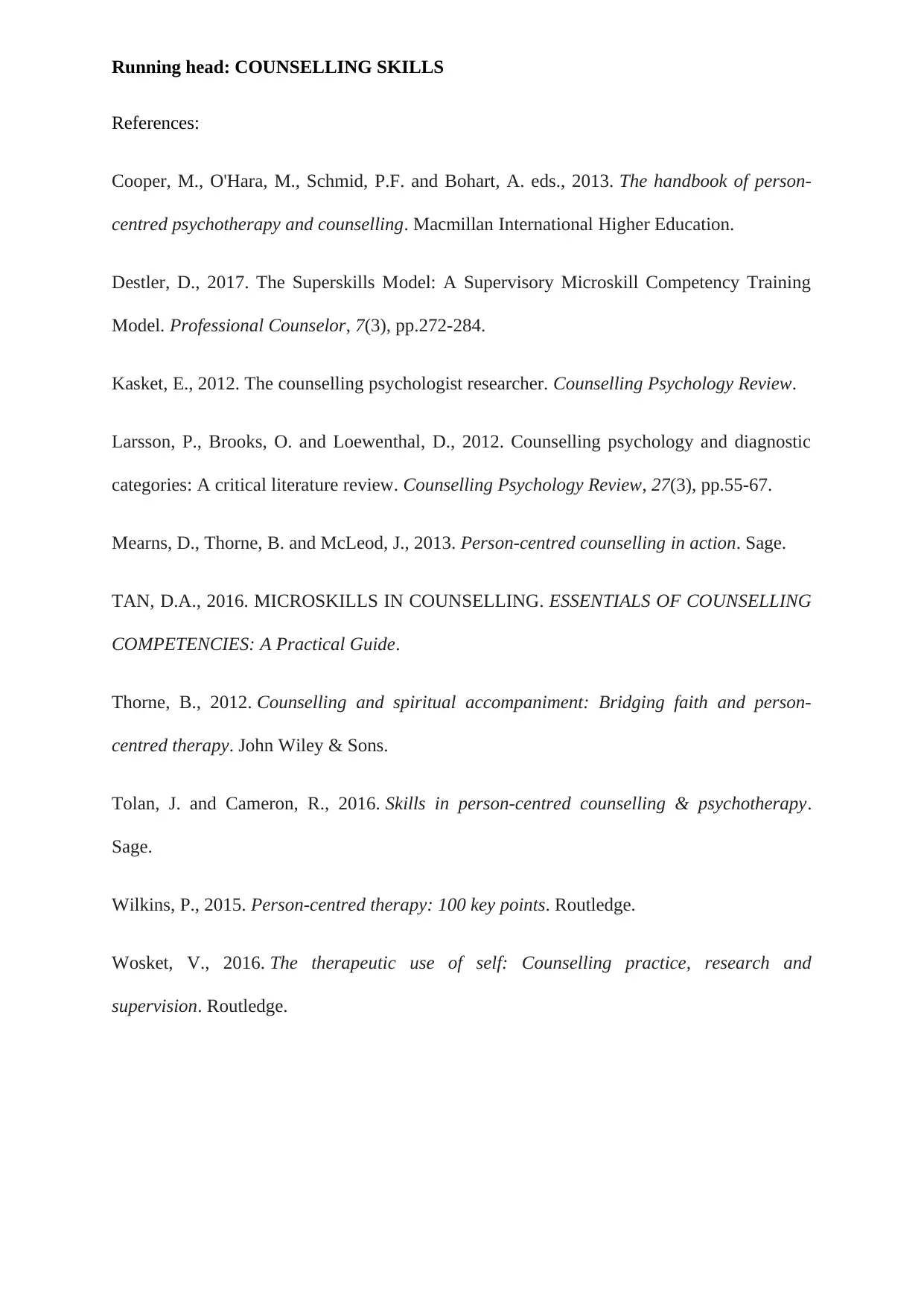
Running head: COUNSELLING SKILLS
References:
Cooper, M., O'Hara, M., Schmid, P.F. and Bohart, A. eds., 2013. The handbook of person-
centred psychotherapy and counselling. Macmillan International Higher Education.
Destler, D., 2017. The Superskills Model: A Supervisory Microskill Competency Training
Model. Professional Counselor, 7(3), pp.272-284.
Kasket, E., 2012. The counselling psychologist researcher. Counselling Psychology Review.
Larsson, P., Brooks, O. and Loewenthal, D., 2012. Counselling psychology and diagnostic
categories: A critical literature review. Counselling Psychology Review, 27(3), pp.55-67.
Mearns, D., Thorne, B. and McLeod, J., 2013. Person-centred counselling in action. Sage.
TAN, D.A., 2016. MICROSKILLS IN COUNSELLING. ESSENTIALS OF COUNSELLING
COMPETENCIES: A Practical Guide.
Thorne, B., 2012. Counselling and spiritual accompaniment: Bridging faith and person-
centred therapy. John Wiley & Sons.
Tolan, J. and Cameron, R., 2016. Skills in person-centred counselling & psychotherapy.
Sage.
Wilkins, P., 2015. Person-centred therapy: 100 key points. Routledge.
Wosket, V., 2016. The therapeutic use of self: Counselling practice, research and
supervision. Routledge.
References:
Cooper, M., O'Hara, M., Schmid, P.F. and Bohart, A. eds., 2013. The handbook of person-
centred psychotherapy and counselling. Macmillan International Higher Education.
Destler, D., 2017. The Superskills Model: A Supervisory Microskill Competency Training
Model. Professional Counselor, 7(3), pp.272-284.
Kasket, E., 2012. The counselling psychologist researcher. Counselling Psychology Review.
Larsson, P., Brooks, O. and Loewenthal, D., 2012. Counselling psychology and diagnostic
categories: A critical literature review. Counselling Psychology Review, 27(3), pp.55-67.
Mearns, D., Thorne, B. and McLeod, J., 2013. Person-centred counselling in action. Sage.
TAN, D.A., 2016. MICROSKILLS IN COUNSELLING. ESSENTIALS OF COUNSELLING
COMPETENCIES: A Practical Guide.
Thorne, B., 2012. Counselling and spiritual accompaniment: Bridging faith and person-
centred therapy. John Wiley & Sons.
Tolan, J. and Cameron, R., 2016. Skills in person-centred counselling & psychotherapy.
Sage.
Wilkins, P., 2015. Person-centred therapy: 100 key points. Routledge.
Wosket, V., 2016. The therapeutic use of self: Counselling practice, research and
supervision. Routledge.
1 out of 7
Related Documents
Your All-in-One AI-Powered Toolkit for Academic Success.
+13062052269
info@desklib.com
Available 24*7 on WhatsApp / Email
![[object Object]](/_next/static/media/star-bottom.7253800d.svg)
Unlock your academic potential
Copyright © 2020–2025 A2Z Services. All Rights Reserved. Developed and managed by ZUCOL.





